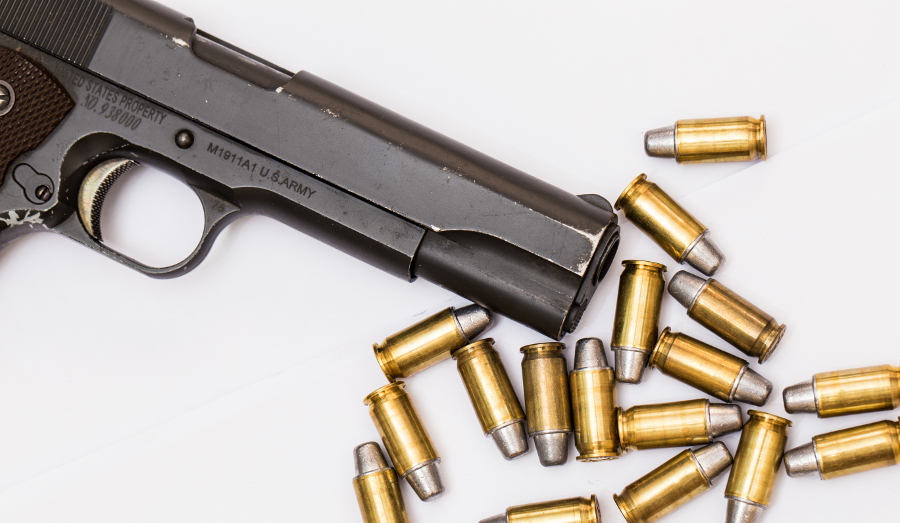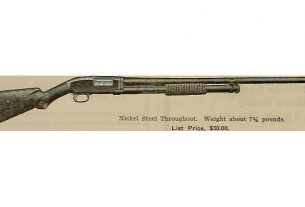For over a hundred years, the biggest debate among handgun shooters has been: 9mm or .45? American soldiers were issued revolvers in various .45-caliber cartrdiges such as .45 Colt from the 1870s onward. But in 1893 those single-action revolvers were replaced with the double-action Colt M1892, which was chambered in .38 Long Colt, which featured a .357-inch bullet similar in diameter to later 9mm cartridges.
The .38 Long Colt was much derided for its lack of stopping power, leading the military to make an emergency issue of .45-caliber revolvers. So when the military decided to hold trials for a pistol to become its standard-issue sidearm, the request naturally came with the criteria that the pistol fire a .45-caliber cartridge.
The .45 ACP cartridge was designed by John Moses Browning for his experimental Colt Model 1905 pistol. That pistol competed against a .45-caliber chambered Luger pistol and a .45 pistol from Savage in Army trials, with the Colt pistol coming in victorious. That pistol then developed into the iconic Model 1911 pistol that still remains popular with many shooters today.
The .45 ACP became a very popular cartridge both with soldiers and with sport shooters. The .45 ACP was used in American submachine guns such as the M1928 and M1 Thompson submachine guns and the M3 “grease gun.” The cartridge developed a reputation for stopping power, with numerous anecdotal stories coming from World War II illustrating the knockdown power of the .45 ACP cartridge versus the 9mm Luger cartridge used in German submachine guns.
Most standard loadings of the .45 ACP feature a 230-grain bullets at about 850 feet per second, with a maximum chamber pressure of 21,000 PSI. That’s heavy and slow by modern standards, but it makes for an effective stopper. Muzzle energy of most standard pressure loadings is between 360 and 400 foot-pounds of energy, or about 20-35% more than most standard 9mm loadings.
There is also a +P loading of the .45 ACP, which allows for a maximum pressure of 23,000 PSI. Energy in these loadings can approach or exceed 500 foot-pounds of muzzle energy. These loads should not be fired in older pistols, but should be used only in modern pistols such as the Glock 21 that can handle the increased wear and tear that will result.
The .45 ACP’s reputation as a man-stopper was made through military use, which requires the use of full metal jacket or “ball” ammunition. With the development of hollowpoint bullets, smaller cartridges such as the 9mm Luger began to become more effective. In the eyes of many shooters, the 9mm cartridge with effective hollowpoints can offer similar performance to the .45 ACP while offering more ammunition capacity and less recoil.
Most 9mm hollowpoint bullets will expand to a diameter of at least .50” to .60”, with some even expanding close to .75”. Compare that to .45 ACP, in which most bullets expand between .60” and .70” and only a handful expand above .75”. That’s not a huge difference in creating a large and effective wound channel. Then consider that the highest capacity .45 ACP pistols such as the plus-size Glock 21 only hold 13 rounds, while compact 9mm pistols such as the Glock 19 hold 15 to 17 rounds while weighing less and being more easily concealable, and you can see why so many shooters eschew the .45 ACP in favor of the 9mm.
Still, the .45 ACP is no slouch, and those who handload are able to gain the full benefits of the .45 ACP’s greater power potential. And for backwoods carry with heavy hardcast lead bullets that punch big holes through dangerous animals, the .45 ACP has a significant advantage over the 9mm. A 260-grain lead bullet at 900+ feet per second will be far more effective against a charging black bear than a 147-grain 9mm bullet.
With over 100 years of solid performance behind it, the .45 ACP won’t be going anywhere soon. And it’s still the third-most popular cartridge in the country, behind 9mm Luger and 5.56×45/.223 Remington. That should make it easy to find ammunition for your .45 ACP firearms in a survival scenario. So if you’re on the fence about 9mm or .45, you definitely won’t go wrong with .45 ACP.
This article was originally posted on Red Tea News.





